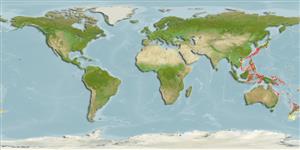Classification / Names
Populärnamn | synonymer | Catalog of Fishes(Släkte, Arter) | ITIS | CoL | WoRMS | Cloffa
>
Pleuronectiformes (Flatfishes) >
Cynoglossidae (Tonguefishes) > Symphurinae
Etymology: Symphurus: Greek, syn, symphysis = grown together + Greek, oura = tail (Ref. 45335); bathyspilus: From the Greek bathy meaning deep, in reference to deepwater habitat, and spilos, meaning spot, in reference to the numerous, small, reddish speckles on the blind-side body (Ref. 51120).
Environment: milieu / climate zone / djupintervall / distribution range
Ekologi
marina djupbottenlevande; djupintervall 248 - 500 m (Ref. 51120), usually 335 - 431 m (Ref. 51120). Deep-water
Western Central Pacific: Philippines and southern Indonesia.
Size / Vikt / Age
Könsmognad: Lm ? range ? - ? cm
Max length : 12.1 cm SL hane/ej könsbestämd; (Ref. 51120)
Short description
Bestämningsnycklar | Morfologi | Morfometri
Mjukstrålar i ryggfenan (totalt) : 91 - 100; Mjukstrålar i analfenan: 78 - 87; Ryggkotor: 50 - 54. Characterized by the combination of a predominant 1-2-2 pattern of interdigitation of dorsal pterygiophores and neural spines; 14 caudal-fin rays; 91-100 dorsal-fin rays; 78-87 anal-fin rays; 50-54 vertebrae, a pointed snout, black peritoneum, and distinctive features of its ocular- and blind-side coloration (in alcohol) including ocular-side background coloration uniformly bright (freshly captured) to darker reddish-brown with some specimens having a series of faint, reddish-brown, incomplete crossbands; outer surface of ocular-side opercle yellowish with reddish-brown speckles; dorsal and anal fins darker reddish-brown anteriorly, fading to a pale reddish posteriorly; blind side uniformly yellowish to straw-colored, except proximal pterygiophore regions of dorsal and anal fins with dense covering of reddish-brown speckles; both sides of dorsal, anal, and pelvic fins covered with dense concentrations of small red speckles; speckling especially dense on blind-side body in region around anus and also on both sides of pelvic fin (Ref. 51120).
Body shape (shape guide): short and / or deep.
Appears to feed on small fishes and crustaceans (Ref. 51120).
Life cycle and mating behavior
Könsmognad | Reproduktion | Lek | Ägg | Fecundity | Larver
Krabbenhoft, T.J. and T.A. Munroe, 2003. Symphurus bathyspilus: a new cynoglossid flatfish (Pleuronectiformes: Cynoglossidae) from deepwaters of the Indo-West Pacific. Copeia 2003(4):810-817. (Ref. 51120)
IUCN Red List Status (Ref. 130435: Version 2025-1)
Threat to humans
Harmless
Human uses
Verktyg
Special reports
Download XML
Internet-källor
Estimates based on models
Preferred temperature (Ref.
123201): 6.9 - 13.5, mean 9.8 °C (based on 121 cells).
Phylogenetic diversity index (Ref.
82804): PD
50 = 0.5000 [Uniqueness, from 0.5 = low to 2.0 = high].
Bayesian length-weight: a=0.01072 (0.00507 - 0.02267), b=3.11 (2.92 - 3.30), in cm total length, based on LWR estimates for this (Sub)family-body shape (Ref.
93245).
Trofisk nivå (Ref.
69278): 3.3 ±0.4 se; based on size and trophs of closest relatives
Resiliens (Ref.
120179): Mellan, lägsta populationsfördubblingstid 1,4-4,4 år (Assuming tmax>3).
Fishing Vulnerability (Ref.
59153): Low vulnerability (10 of 100).
🛈
